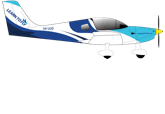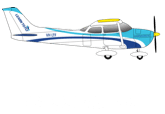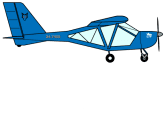Frequently
Asked
Questions
Search Here
Before You Fly
Who can be a pilot? What are the requirements to start flight training?
Anyone can Learn To Fly! Learning to fly is not as hard as you might imagine, however, it does require dedicated time. It will require your mind and your body, giving you new muscle memory skills and knowledge. The good news is that just about anyone can learn to fly, it’s all up to YOU.
You don’t need any formal education to start your flight training, but there are other requirements that you need to satisfy including age, English proficiency and an aviation medical check.
We suggest you must be a minimum age of 14 and be able to understand and speak English to start the flight training. Some students start their theory training at the age of 13.
Moreover, you don’t need any formal education to start your flight training, you do not need to study physics or maths at school to obtain a pilot licence. Having this knowledge certainly does help, but is in no way a requirement. If you wish to become an airline pilot you may need both physics and maths — both are typically entry requirements. You can check individual airline recruiting websites to view a list of requirements.
What are the minimum requirements for airline employment?
For direct entry to most airlines, you will require a Commercial Pilot Licence (CPL), a Multi-Engine Command Instrument Rating (MECIR) and typically theory credits for the Airline Transport Pilot Licence (ATPL). Airlines will publish their minimum criteria for pilot applications on their website.
Most of the information can be found on the airlines' website.
How old can I start flight training? What are the age limits?
We would recommend students be at least 14 years old, so you can fly solo at 15 and obtain the RPL at 16 and PPL at 17. For the CPL, you need to be at least 18 on the date you get your licence. For younger aviation enthusiasts, we have children’s programs on our flight simulator and offer a number of activities designed to educate and entertain children of all ages. In terms of an upper age limit, you can go flying no matter how old you are as long as you can pass the medical check.
Do I have to have perfect vision to be a commercial pilot CPL? What are the eyesight requirements?
You don't need to have perfect eyesight as long as your vision can be corrected to 20/20 with glasses or contacts, you will be eligible for a CASA Class 1 & Class 2 Medical Certificate. This makes you eligible to fly as a commercial pilot. If you wish to obtain your Commercial Pilot Licence, you will need to conduct a CASA Class 1 Medical Clearance.
I want to become a pilot, how do I get started?
We believe you probably have an ambition or dream to learn to fly, however, you don’t know if you like it or have an aptitude for it or not until you fly once. A Trial Introductory Flight (TIF) is a good starting point. If you are uncertain about learning to fly, or if you just want to get airborne to “feel what it is like” before you commence training, a Trial Introductory Flight is an air experience flight; a way of sampling flight training without making any commitment to joining the school.
After the TIF, if you are happy to continue and become a pilot, then the first thing to ask yourself is whether you want to fly for fun, or for a career. The answer to this question will determine the training you need to do and the licences you need to hold.
The Recreational Pilot Licence (RPL) is your first step. This course teaches you the basics of flying and builds towards your first solo flight. Once you achieve your RPL you are able to fly CASA-approved aircraft up to 25nm from your departure aerodrome and carry up to 3 passengers.
The Private Pilot Licence (PPL) introduces navigation training, and PPL holders can fly CASA-approved aircraft anywhere in Australia with up to 5 passengers. The RPL and PPL do not allow you to take on paid work as a pilot.
If you want to work as a pilot and be paid to fly, you will need to complete the Commercial Pilot Licence (CPL) course. If you commence a CPL course from the beginning, then the training will take you through RPL and PPL syllabus before moving onto CPL syllabus. If you already hold a PPL you can start the CPL syllabus.
Learn To Fly offers beginner courses like the Learn To Fly Starter Set and Learn To Fly First Solo programs that allow you to get a taste of flying before committing to further training. All of the training in these courses can be applied as prior learning for students who do wish to proceed further.
After the TIF, if you are happy to continue and become a pilot, then the first thing to ask yourself is whether you want to fly for fun, or for a career. The answer to this question will determine the training you need to do and the licences you need to hold.
The Recreational Pilot Licence (RPL) is your first step. This course teaches you the basics of flying and builds towards your first solo flight. Once you achieve your RPL you are able to fly CASA-approved aircraft up to 25nm from your departure aerodrome and carry up to 3 passengers.
The Private Pilot Licence (PPL) introduces navigation training, and PPL holders can fly CASA-approved aircraft anywhere in Australia with up to 5 passengers. The RPL and PPL do not allow you to take on paid work as a pilot.
If you want to work as a pilot and be paid to fly, you will need to complete the Commercial Pilot Licence (CPL) course. If you commence a CPL course from the beginning, then the training will take you through RPL and PPL syllabus before moving onto CPL syllabus. If you already hold a PPL you can start the CPL syllabus.
Learn To Fly offers beginner courses like the Learn To Fly Starter Set and Learn To Fly First Solo programs that allow you to get a taste of flying before committing to further training. All of the training in these courses can be applied as prior learning for students who do wish to proceed further.
Do you offer full time courses?
Yes we do, we offer full time courses for both local and international students.
How long does it take to obtain a pilot licence? How often do I need to train?
A Recreational Pilot Licence (RPL) typically takes 30 - 35 hours of flight time. A Private Pilot Licence (PPL) typically takes another 30 - 35 hours of flight time. A Commercial Pilot Licence (CPL) will take 150 (Integrated) hours or 200 hours (Non-Integrated) of flight time from scratch.
The time it takes you will depend heavily on how frequently you are able to fly, how flexible your schedule is, and your overall commitment to study. We have the aircraft and instructor availability for you to complete your licences as fast as you are able to pass each of the required competencies.
The more you are able to train, the more successful your training will be. Experience has shown that students who study and train more regularly are able to retain and build on their knowledge more easily. The more time you spend at your flight school (even if you aren't flying), the more you will learn. Whilst we understand that everybody has different time commitments in their lives, we recommend that you train a minimum of once a week.
Is there much home study? Do you provide online theory training?
How you decide to manage your time between studying at flight school and studying at home is up to you. Experience shows that those who are able to spend more time studying at flight school tend to absorb more knowledge.
If you're spending enough time at flight school then you may not need to study much at home, but if you aren't then we recommend that you study fairly regularly at home so that you retain what you have learnt and are ready for your next lesson.
In addition, we provide online training via our student portal. We offer the following theory courses
- Recreational Pilot Licence (RPL) Theory Course
- Private Pilot Licence (PPL) Theory Course
- Commercial Pilot Licence (CPL) Theory Course
- Instrument Rating Theory Examination (IREX) Theory Course
Are there any time limits on finishing a flight training course?
Since flight training is competency-based, there are no times limits imposed on completing courses. Overseas students flying in Australia will however need to be aware of time limits relating to their visa. Some components of theory, licences and endorsements do have expiry or maintenance periods but this can be easily managed during your flight training.
Is flight training expensive? How much does it cost to become a pilot?
The cost of becoming a pilot depends on the type of training you want to do, and also the aircraft that you want to fly. If you just want to fly for fun then you may only need a Recreational Pilot Licence (RPL) or Private Pilot Licence (PPL). If you want to fly for a career then you will need to hold a Commercial Pilot Licence (CPL), which requires building at least 150 flying hours.
Becoming a pilot can be an expensive process, but it shouldn’t prohibit you from achieving your dreams. We want to make flight training accessible to as many people as possible, which is why we provide flexible and transparent pricing options. We offer package options for our courses that contain all of the theory and practical flight training required to complete the required syllabus. On eligible courses, you are able to pay in interest-free monthly instalments via SplitIt. Note that there are ancillary items you may need to purchase in addition to the package inclusions. We also offer Pay As You Fly options for many courses, where you can pay as you progress.
Some courses also allow you to utilise our state-of-the-art flight simulators, which can dramatically reduce your costs by reducing the amount of time you may need to spend flying in an actual aircraft. We recommend chatting to one of our flight training specialists about which payment option is best suited to you.
How to get to Moorabbin Airport from Melbourne City?
The Moorabbin Airport area is served by frequent bus and train services. The bus service has a pickup and drop off point adjacent to the Moorabbin DFO shopping complex. It is a 5-minute walk from the Moorabbin DFO bus stop to Learn To Fly Melbourne's base at 22-24 Northern Avenue.
There are also two railway stations – Mentone and Cheltenham – that are local to Moorabbin Airport. Buses depart from both stations to the nearby DFO shopping complex. Always check timetables for schedule details, particularly for weekends and evenings. All timetables can be found at https://www.ptv.vic.gov.au/timetables
How safe are small aircraft? Is flight training safe? Will I get airsick?
There is a certain amount of risk in everything we do. Flying an aircraft has some degree of risk, and for that reason, they must be treated with care and respect. If you learn to fly safely with experienced and professional instructors then you will go a long way towards reducing that risk. Your safety and that of the aircraft and its occupants is the most important objective for our instructors. All of our aircraft are maintained to the highest Australian Civil Aviation Safety Authority (CASA) standards. Statistically, flying is actually safer than driving a car on the road!
Airsickness is completely dependant on the individual. Some people will have a tendency to feel airsick initially, but as time passes and you feel more confident in the aircraft the chance of feeling sick is significantly reduced. If you have previously suffered motion sickness it's best to let your instructor know.
Will I be covered by insurance when I am at Learn To Fly?
Learn to Fly has insurance cover for the following:
- $5 million Liability Insurance which covers all of our flying operations.
- $15 million Hangar Keeper's Liability Insurance which covers all ground operations including incidents and accidents happening within the school and on the apron.
Flight Training
Do you offer full time courses?
Yes we do, we offer full time courses for both local and international students.
What types of exams will I need to pass to get my pilot licence?
For each pilot licence, you are required to pass 3 types of exams - an oral test, written test and practical flying test.
-
- Written Test: This is a multiple-choice test that covers all areas of aviation theory relating to your licence course. There are many resource guides available to assist with preparation including books, mock exam questions, and the best resource of all - your Learn To Fly instructors and fellow students. We recommend spending as much time studying at school as you can, as well as time outside of school studying on your own. Most written aviation theory exams require a 70% pass mark.
-
- Oral Test: The day you take your practical flying test in the aircraft, your Flight Examiner will conduct an oral interview where you will be asked to discuss all the theory and knowledge areas you’ve studied during the course. This includes aircraft systems, weather, aerodynamics, air laws, airport operations, airspace designations and operations, charts, aircraft performance, and much more. The oral exam requires study, preparation and understanding on your part. Your flight instructor will be able to assist you with preparation, as will your fellow students (especially those with the first-hand experience completing the exam).
- Practical Test: Your practical flying test takes place in the aircraft, and this is where all your training comes together. You will fly with an official flight Flight Examiner who will ask you to perform all the manoeuvres and skills you have been working on from the beginning of your flight training. Your flight instructor will assist you in preparing for the actual test scenario in your flights leading up to the test.
What is a proficiency check and do I need to have one?
A proficiency check is an assessment of your skills and knowledge in a particular operational area. Pilots are required to undertake proficiency checks to ensure they continue to be competent in conducting particular kinds of operations.
After gaining a qualification, it is normal for some skills to deteriorate over time. A proficiency check ensures your piloting skills continue to meet the standards described in the Part 61 Manual of Standards, and where applicable, those of your operator.
The following proficiency checks are prescribed under Part 61:
- Instrument rating proficiency check (IPC)
- Instructor rating proficiency check
- Examiner rating proficiency check
- Aerial application rating proficiency check
- Night vision imaging system proficiency check
What is a flight review and do I need to have one?
A flight review is an opportunity to receive training that refreshes your flying skills and operational knowledge. Pilots undertake flight reviews to ensure they continue to be competent flying particular types of aircraft or exercising the privileges of an operational rating.
After gaining a qualification, it is normal for some skills to deteriorate over time. A flight review ensures your piloting skills remain or are brought back up to standard. Flight reviews are also used to meet the International Civil Aviation Organization (ICAO) requirement for countries to ensure pilots continue to be competent in exercising the privileges of their licences and ratings.
If you hold a pilot licence, rating, or endorsement, and are unsure whether you require a flight review to demonstrate certain aspects of your qualifications, then please contact us.
After gaining a qualification, it is normal for some skills to deteriorate over time. A flight review ensures your piloting skills remain or are brought back up to standard. Flight reviews are also used to meet the International Civil Aviation Organization (ICAO) requirement for countries to ensure pilots continue to be competent in exercising the privileges of their licences and ratings.
If you hold a pilot licence, rating, or endorsement, and are unsure whether you require a flight review to demonstrate certain aspects of your qualifications, then please contact us.
Is there much home study? Do you provide online theory training?
How you decide to manage your time between studying at flight school and studying at home is up to you. Experience shows that those who are able to spend more time studying at flight school tend to absorb more knowledge.
If you're spending enough time at flight school then you may not need to study much at home, but if you aren't then we recommend that you study fairly regularly at home so that you retain what you have learnt and are ready for your next lesson.
In addition, we provide online training via our student portal. We offer the following theory courses
- Recreational Pilot Licence (RPL) Theory Course
- Private Pilot Licence (PPL) Theory Course
- Commercial Pilot Licence (CPL) Theory Course
- Instrument Rating Theory Examination (IREX) Theory Course
Are there any time limits on finishing a flight training course?
Since flight training is competency-based, there are no times limits imposed on completing courses. Overseas students flying in Australia will however need to be aware of time limits relating to their visa. Some components of theory, licences and endorsements do have expiry or maintenance periods but this can be easily managed during your flight training.
How long does each flying lesson last?
Whilst studying your Recreational Pilot Licence (RPL), you will generally spend around 2-2.5 hours at the airport — 1 hour in the air, with the remaining 1-1.5 hours split between classroom briefing, aircraft preparation and debriefing.
When you are studying your Private Pilot Licence, you may need 4-6 hours at the airport — which will be made up of 2-4 hours in the air, with the remaining 1-2 hours split between flight planning, classroom briefing, aircraft preparation and debriefing.
Can I take passengers on my Trial Introductory Flight lesson?
Sorry, you are not allowed to bring passengers on a Trial Introductory Flight.
What happens if the weather is bad on the day of my flight?
Safety is always paramount at Learn To Fly Melbourne, and for both flight lessons and Trial Introductory Flights, we will assess the weather ahead of time to determine whether your flight has a good chance of going ahead. If it is looking likely that the weather may cause your flight to be cancelled, we will contact you to reschedule. There may be times when changeable weather means that we need to cancel flights unexpectedly or at short notice, but we try to be as proactive as possible.
For student pilots, your instructor is trained to assess weather conditions and determine whether flying will be suitable for your level of experience. There may be times when your instructor “pushes the envelope” and encourages you to fly in less than suitable conditions. This is done so that experience is gained with poor weather conditions and techniques that help maintain a good safety margin.
How much experience does my Flight Instructor have?
Flight Instructor experience and seniority are divided into three grades numbered 1 through 3, with Grade 1 being the highest. An instructor’s progression to a higher grade is based on achieving at least the required number of flying instruction hours as well as satisfactory reviews. Several hundreds of hours are involved in this process.
In addition to this, instructors often undertake other ratings and endorsements, fly recreationally and participate in other flying activities. Consequently, their total flying hours is likely to be much greater than just their instruction hours, as will be their overall flying experience. Several of Learn To Fly Melbourne’s instructors have total flying hours in the thousands, and even some in the tens of thousands!
How safe are small aircraft? Is flight training safe? Will I get airsick?
There is a certain amount of risk in everything we do. Flying an aircraft has some degree of risk, and for that reason, they must be treated with care and respect. If you learn to fly safely with experienced and professional instructors then you will go a long way towards reducing that risk. Your safety and that of the aircraft and its occupants is the most important objective for our instructors. All of our aircraft are maintained to the highest Australian Civil Aviation Safety Authority (CASA) standards. Statistically, flying is actually safer than driving a car on the road!
Airsickness is completely dependant on the individual. Some people will have a tendency to feel airsick initially, but as time passes and you feel more confident in the aircraft the chance of feeling sick is significantly reduced. If you have previously suffered motion sickness it's best to let your instructor know.
How do I monitor whether my flight training is progressing well?
It’s best to be critical and demanding in regards to your flight training to ensure you are getting the most value from your time and money. There are a few warning signs you can lookout for to ensure your training is unfolding the way it should. Things to watch out for include:
- Constant rescheduling or cancellation of lessons not due to weather
- Failure to provide proper briefings
- Constant changes of Instructor
- Inconsistency within the school
- Limited or no time with senior pilots
- No proper debriefing
- Poor paperwork
Will I be covered by insurance when I am at Learn To Fly?
Learn to Fly has insurance cover for the following:
- $5 million Liability Insurance which covers all of our flying operations.
- $15 million Hangar Keeper's Liability Insurance which covers all ground operations including incidents and accidents happening within the school and on the apron.
If I get a Flight Instructor Rating or a Commercial Pilot Licence, will I get a job?
We do hire our students including international students and have flight instructors who are employed in their first flying job. We are committed to the development of future pilots and transitioning them into pilot careers once they hold the required licences. We also offer Pilot Job Guarantee Program, contact us to get more information.
How much does a Private Pilot Licence (PPL) cost?
In Australia, to start the Private Pilot Licence (PPL) training, you’ll first need to finish the Recreational Pilot Licence (RPL) training syllabus. So, to determine the total cost of obtaining your PPL you will also need to factor in that training. The overall cost will also depend on what aircraft you choose to fly during your training.
Some cost examples are below, based on our flight package pricing. These packages can be split into interest-free monthly instalments via SplitIt. Note that there are some ancillary items not included in the flight package, such as landing fees at different airports. We also have Pay As You Fly options available.
To view current pricing, aircraft options, package inclusions and all payment options, please download the Recreational Pilot Licence and Private Pilot Licence course guides.
How much does a Commercial Pilot Licence cost?
The Commercial Pilot Licence (CPL) course sees you progress through RPL and PPL syllabus before moving onto CPL theory and practical training, and then hour building as you accumulate at least 150 flying hours. The cost will vary based on the aircraft that you choose to fly in during your training, and there are specific aircraft requirements for CPL that may mean you need to change aircraft when you start the CPL syllabus.
The most economical way to obtain a CPL is with our CPL flight package. The package includes all of the required theory and practical aircraft training, and minimum flying hours, and also makes use of our state-of-the-art simulators to keep costs down.
Note that there are ancillary items that are not included in the package that you will incur during your training, such as landing fees at other aerodromes. Many students end up flying more than the minimum hours before they take their CPL flight test, so that also needs to be considered. You may wish to add in multi-engine training as well. Example CPL packages prices are listed below.
CPL package flying in a Diamond DA40 $77,995
Add in multi-engine training in a Diamond DA42 $83,135
To view current pricing, aircraft options and packages, please download the Commercial Pilot Licence course guide. If you already hold a PPL and just want to complete the CPL syllabus on its own, please chat with one of our flight training specialists.
International Students
What are the minimum requirements for airline employment?
For direct entry to most airlines, you will require a Commercial Pilot Licence (CPL), a Multi-Engine Command Instrument Rating (MECIR) and typically theory credits for the Airline Transport Pilot Licence (ATPL). Airlines will publish their minimum criteria for pilot applications on their website.
Most of the information can be found on the airlines' website.
How to get to Moorabbin Airport from Melbourne City?
The Moorabbin Airport area is served by frequent bus and train services. The bus service has a pickup and drop off point adjacent to the Moorabbin DFO shopping complex. It is a 5-minute walk from the Moorabbin DFO bus stop to Learn To Fly Melbourne's base at 22-24 Northern Avenue.
There are also two railway stations – Mentone and Cheltenham – that are local to Moorabbin Airport. Buses depart from both stations to the nearby DFO shopping complex. Always check timetables for schedule details, particularly for weekends and evenings. All timetables can be found at https://www.ptv.vic.gov.au/timetables
Can I learn to fly with Learn To Fly Melbourne if I am from overseas?
Yes - in fact, most of our students are international. You will need to be able to obtain a visa for entry into Australia, and you will also need to satisfy the relevant course regulatory requirements (which can include English proficiency, medical check, age, and aviation security check). For the Recreational Pilot Licence (RPL), Private Pilot Licence (PPL) and other programs which can be completed in under 3 months, students may be able to learn whilst on a tourist visa.
For the Commercial Pilot Licence (which takes approximately 12 months), students will most likely require a student visa. We are able to put students in contact with a registered migration agent to assist with requirements and the application process. The best source for specific visa requirements is https://www.homeaffairs.gov.au/ but please contact us if you require further information.
Is student pilot accommodation available?
Yes, we do provide student pilot accommodation. It is from $60 per night or $1,200 a month including water, electricity and internet. Please contact us for more information.
If I get a Flight Instructor Rating or a Commercial Pilot Licence, will I get a job?
We do hire our students including international students and have flight instructors who are employed in their first flying job. We are committed to the development of future pilots and transitioning them into pilot careers once they hold the required licences. We also offer Pilot Job Guarantee Program, contact us to get more information.
Do domestic and international students pay the same price?
All of our pricing is identical between domestic and international students. International students may be required to pay additional fees to obtain a Student Visa where applicable.
Do you provide DGCA syllabus for Indian student pilots?
Yes, we do. We provide a 210 hours DGCA syllabus for Indian students. It includes 15 hours of multi-engine training, 5 hours of Pilot In Command time at night and 40 hours of instrument time. This means that you can easily convert your CASA CPL to the DGCA CPL licence back in India.
Can I work in Australia on a Student Visa?
If you are an International Student on a student visa you are permitted to work 20 hours a week. For full visa conditions please visit https://www.homeaffairs.gov.au/ or contact a registered migration agent.
How can I convert my overseas licence?
Please see the following procedures:
- Make sure your PPL or CPL is from an ICAO- approved country.
- Apply for an ARN with CASA
- Obtain an Australian CASA medical certificate
- Hold or pass an English Language Proficiency assessment
- Apply for an ASIC
- Fill out CASA form 61-4A
- For PPL - A flight review must be completed to make your PPL valid
- For a CPL - You will have to sit two CPL theory exams and a flight test. After completion, you will then submit CASA form 61-4B
Licences and Ratings
Are there different types of pilot licences?
Yes, there are different types of licences. You can obtain a Recreational Pilot Licence (RPL), a Private Pilot Licence (PPL) or a Commercial Pilot Licence (CPL). A CPL is required if you intend to obtain work as a pilot. Details of paths to each licence can be found in our Courses section.
What is the difference between a Recreational Pilot Certificate (RPC) and Recreational Pilot Licence (RPL)?
The Recreational Pilot Certificate (RPC) is issued by Recreational Aviation Australia (RAAus) whereas the Recreational Pilot Licence (RPL) is issued by CASA. The RPC allows you to fly any aircraft under 600kgs (e.g. Sling 2) and take up to 1 passenger whereas RPL allows you to fly any aircraft up to 1500kgs (e.g. Cessna 172 or Diamond DA40) and carry up to 3 passengers.
At Learn To Fly Melbourne, we offer both RPC and RPL.
Students can choose to achieve their RPL through RPC. Student can gain their RPC through the RPC training program, the RPC is equivalent to an RPL. Once students receive their RPC, they can apply to CASA for the issuance of an RPL by simply filling in a form. Afterwards, to activate the RPL, a flight review on a GA aircraft is needed and this can be done by us as well.
How do I get a Private Pilot Licence PPL? What can I do with it?
You must be at least 17 years old to get your Private Pilot Licence (PPL). You also need to do the following for the category rating you want to get with your PPL:
- Hold a RPL or you have done an integrated RPL training course;
- Pass a PPL theory exam;
- Meet the minimum aeronautical experience requirements;
- Pass a PPL flight test
How do I get a Commercial Pilot Licence CPL?
If you want to work as a pilot and be paid to fly, you will need to hold a Commercial Pilot Licence (CPL).
You must be at least 18 years old. You also need to do the following for the category rating you want to get with your CPL:
- Complete CPL flight training
- Meet the minimum aeronautical experience requirements
- Pass 7 CPL theory exams set by CASA
- Pass a CPL flight test
How do I get my Air Transport Pilot Licence ATPL?
You must be at least 21 years old to get your ATPL. You also need to do the following for the category rating you want to get with your ATPL:
- Hold either a Commercial Pilot Licence or Multi-Crew Pilot Licence with the same aircraft category rating
- Complete the relevant flight training
- Learn the theory and pass 7 ATPL theory exams
- Complete an approved course of multi-crew cooperation training
- Pass an ATPL flight test
- Meet the minimum aeronautical experience requirements
What types of exams will I need to pass to get my pilot licence?
For each pilot licence, you are required to pass 3 types of exams - an oral test, written test and practical flying test.
-
- Written Test: This is a multiple-choice test that covers all areas of aviation theory relating to your licence course. There are many resource guides available to assist with preparation including books, mock exam questions, and the best resource of all - your Learn To Fly instructors and fellow students. We recommend spending as much time studying at school as you can, as well as time outside of school studying on your own. Most written aviation theory exams require a 70% pass mark.
-
- Oral Test: The day you take your practical flying test in the aircraft, your Flight Examiner will conduct an oral interview where you will be asked to discuss all the theory and knowledge areas you’ve studied during the course. This includes aircraft systems, weather, aerodynamics, air laws, airport operations, airspace designations and operations, charts, aircraft performance, and much more. The oral exam requires study, preparation and understanding on your part. Your flight instructor will be able to assist you with preparation, as will your fellow students (especially those with the first-hand experience completing the exam).
- Practical Test: Your practical flying test takes place in the aircraft, and this is where all your training comes together. You will fly with an official flight Flight Examiner who will ask you to perform all the manoeuvres and skills you have been working on from the beginning of your flight training. Your flight instructor will assist you in preparing for the actual test scenario in your flights leading up to the test.
Are Australian pilot licences recognised by other countries around the world?
Both the Private Pilot Licence (PPL) and Commercial Pilot Licence (CPL) are CASA Part 61 licences, meaning that they are recognised internationally and comply with International Civil Aviation Organization (ICAO) Annex 1 requirements. They also adopt the ICAO's aircraft type and class rating system, simplifying the aircraft endorsement system for pilots.
There are currently 193 ICAO member states worldwide, with that number increasing each year. To fly in other ICAO countries having completed one of the above licences, a simple validation and check flight is normally all that is required.
Where can I fly when I have my pilot licence?
Recreational Pilot Licence (RPL) holders can fly within 25 nautical miles of their departure airport. Private Pilot Licence (PPL) holders are able to fly anywhere within Australia.
What is a proficiency check and do I need to have one?
A proficiency check is an assessment of your skills and knowledge in a particular operational area. Pilots are required to undertake proficiency checks to ensure they continue to be competent in conducting particular kinds of operations.
After gaining a qualification, it is normal for some skills to deteriorate over time. A proficiency check ensures your piloting skills continue to meet the standards described in the Part 61 Manual of Standards, and where applicable, those of your operator.
The following proficiency checks are prescribed under Part 61:
- Instrument rating proficiency check (IPC)
- Instructor rating proficiency check
- Examiner rating proficiency check
- Aerial application rating proficiency check
- Night vision imaging system proficiency check
What is an aircraft type rating, and which aircraft require one?
A type rating authorises a pilot or to operate a particular type of aircraft. All aircraft that are certified for multi-crew operations will have a type rating. Type ratings are also given to specified single-pilot aeroplanes that have performance, complexity or handling characteristics that warrant pilots completing a type-specific training course.
In order to pilot a type-rated aircraft, you need to complete the relevant aircraft type training and flight tests. At the end of the test, assuming you pass, your flight examiner will enter details of the rating in your licence and send a report to CASA so that your records can be updated.
For more information on type ratings, please visit the CASA website.
What is an aircraft class rating?
An aircraft class rating is a flight crew qualification that authorises the holder to operate aircraft that fit the description of the class rating (and are not designated as type-rated aircraft).
For example, a Diamond DA42 is a multi-engine aeroplane and is not designated as a type-rated aircraft, so it is covered by the multi-engine aeroplane class rating. You can find out more about aircraft class ratings on the CASA website.
Do you provide DGCA syllabus for Indian student pilots?
Yes, we do. We provide a 210 hours DGCA syllabus for Indian students. It includes 15 hours of multi-engine training, 5 hours of Pilot In Command time at night and 40 hours of instrument time. This means that you can easily convert your CASA CPL to the DGCA CPL licence back in India.


